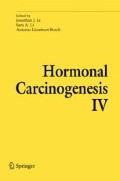Access this chapter
Tax calculation will be finalised at checkout
Purchases are for personal use only
Preview
Unable to display preview. Download preview PDF.
References
Liao S, Kao YH, Hiipakka RA (2001) Green tea: Biochemical and biological basis for health benefits. Vitamins and Hormones 62:1–94.
Liao S, Leininger KR, Sagher D, et al (1965) Rapid effect of testosterone on ribonucleic acid polymerase activity of rat ventral prostate. Endocrinology 77:763–765.
Liao S, Barton RW, Lin AH (1966) Differential synthesis of ribonucleic acid in prostatic nuclei: Evidence for selective gene transcription induced by androgen. Proc Natal Acad Sci USA 55:1593–1600.
Liao S, Lin AH, Barton RW (1966) Selective stimulation of ribonucleic acid synthesis in prostatic nuclei by testosterone. J Biol Chem 241:38963871.
Anderson KM, Liao S (1968) Selective retention of dihydrotestosterone by prostatic nuclei. Nature 219:277–279.
Fang S, Anderson KM, Liao S (1969) Receptor proteins for androgens: On the role of specific proteins in selective retention of 17β-hydroxy-5α-androstan-3-one by ventral prostate in vivo and in vitro. J. Biol Chem 244:6584–6595.
Bruchovsky N, Wilson JD (1968) The conversion of testosterone to 5α-androstan-17β-ol-3-one by rat prostate in vivo and in vitro. J Biol Chem 243:2012–2021
Liao S, Fang S (1969) Receptor proteins for androgens and the mode of action of androgens on gene transcription in ventral prostate. Vitamins and Hormones 27:17–90.
Fang S, Liao S (1971) Androgen receptor: Steroid-and tissue-specific retention of a 17β-hydroxy-5α-androstan-3-one protein complex by cell nuclei of ventral prostate. J Biol Chem 246:16–24.
Liao S, Kokontis JM, Sai T, et al (1989) Androgen receptors: Structures, mutations, antibodies and cellular dynamics. J. Steroid Biochem 34:41–51.
Hiipakka RA, Liao S (1998) Molecular mechanism of androgen action. Trend in Endocrinol Metab 9:317–324.
Fan S, Liao S (1969) Antagonistic action of anti-androgens on the formation of a specific dihydrotestosterone-receptor protein complex in rat ventral prostate. Mol. Pharmacol. 5:428–431.
McKenna NJ, O’Malley BW (2002) Minireview: Nuclear receptor coactivator—An Update. Endocrinology 143:24612465.
Russell DW, Wilson JD (1994) Steroid 5α-reductase: Two genes/two enzymes. Annu Rev Biochem 63:25–61.
Liang T, Liao S (1992) Inhibition of steroid 5α-reductase by specific aliphatic unsaturated fatty acids. Biochem J 285:557–562.
Liao S, Hiipakka RA (1995) Selective inhibition of steroid 5α-reductase isozymes by tea epicatechin-3-gallate and epigallocatechin-3-gallate Biochem Biophys Res Commun 214:833–838.
Hiipakka RA, Zhang H-Z, Dai W, et al (2002) Structure-activity relationship for inhibition of human 5α-reductases by polyphenols. Biochem Pharmacol 63:1165–1176.
Liang T, Liao S (1997) Growth suppression of hamster flank organs by topical application of γ-linolenic and other fatty acid inhibitors of 5α-reductase. J Invest Dermatol 109:152–157.
Liao S, Lin J, Dang MT, et al (2001) Growth suppression of hamster organs by topical application of catechins, alizarin, curcumin, and myristoleic acid. Arch Dermatol Res 293:200–205.
Huggins C, Steven, RE, Hodges CV (1941) Studies on prostate cancer II. The effects of castration on advanced carcinoma of prostate gland. Arch of Sug 43:209–223.
Kokontis JM, Takakura K., Hay N, et al (1994) Increased androgen receptor activity and altered c-myc expression in prostate cancer cells after long-term androgen deprivation. Cancer Research 54:1566–1573.
Kokontis JM, Liao S (1999) Molecular action of androgen in the normal and neoplastic prostate. Vitam Horm 55:219–307.
Kokontis JM, Hay N, Liao S (1998) Progression of LNCaP prostate tumor cells during androgen deprivation: hormone-independent growth, repression of proliferation by androgen, and role for p27kip1 in androgen-induced cell cycle arrest. Mol Endocrinol 12:941–953.
Umekita Y, Hiipakka RA, Kokontis JM, et al (1996) Human prostate tumor growth in athymic mice: inhibition by androgens and stimulation by finasteride. Proc Natl Acad Sci USA 93:11802–11807.
Liao S, Umekita Y, Guo J, et al (1995) Growth inhibition and regression of human prostate and breast tumors in athymic mice by tea epigallocatechin gallate. Cancer Letter 96:239–243.
Kao YH, Hiipakka RA, Liao S (2000) Modulation of endocrine systems and food intake by green tea epigallocatechin gallate. Endocrinology 141:980–987.
Kao YH, Hiipakka RA, Liao S (2000) Modulation of obesity by a green tea catechin. Am J Clin Nutr 72:1232–1233.
Gupta S, Hastak K, Ahmad N, et al (2001) Inhibition of prostate carcinogenesis in TRAMP mice by oral infusion of green tea polyphenols. Proc Natl Acad Sci USA 98:10350–10355.
Thompson IM (2003) The influence of finasteride on the development of prostate cancer. N Engl J Med 349:211–220.
Author information
Authors and Affiliations
Editor information
Editors and Affiliations
Rights and permissions
Copyright information
© 2005 Springer Science+Business Media, Inc.
About this chapter
Cite this chapter
Liao, S. et al. (2005). Four Stages of Prostate Cancer: Suppression and Eradication by Androgen and Green Tea Epigallocatechin Gallate. In: Li, J.J., Li, S.A., Llombart-Bosch, A. (eds) Hormonal Carcinogenesis IV. Springer, Boston, MA. https://doi.org/10.1007/0-387-23761-5_17
Download citation
DOI: https://doi.org/10.1007/0-387-23761-5_17
Publisher Name: Springer, Boston, MA
Print ISBN: 978-0-387-23783-1
Online ISBN: 978-0-387-23761-9
eBook Packages: MedicineMedicine (R0)

